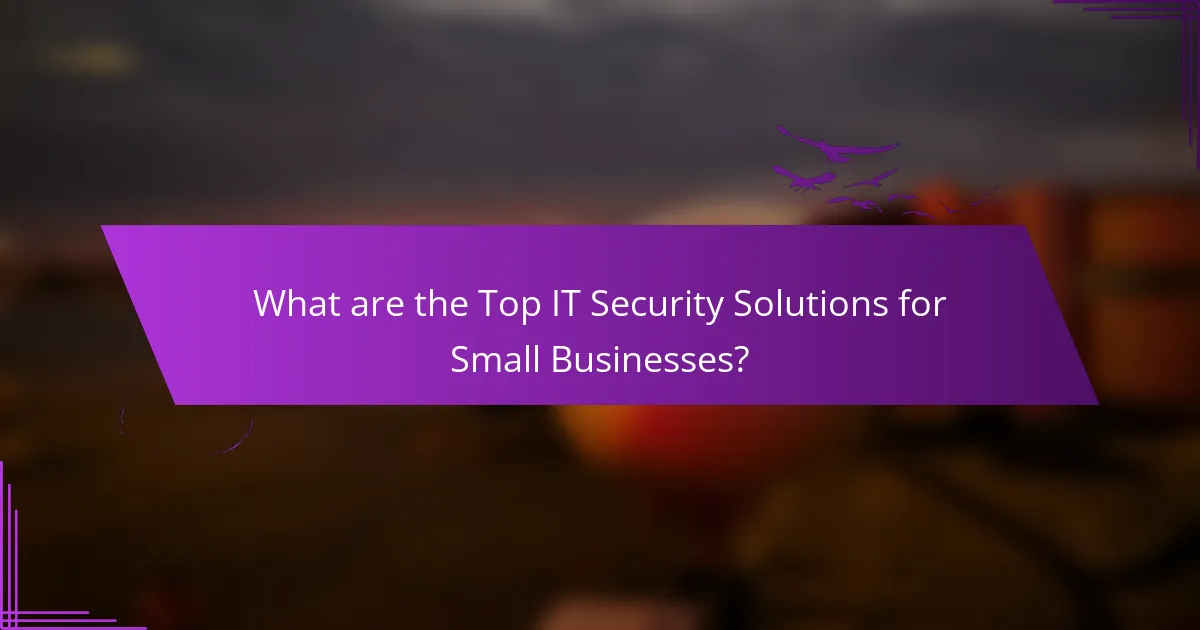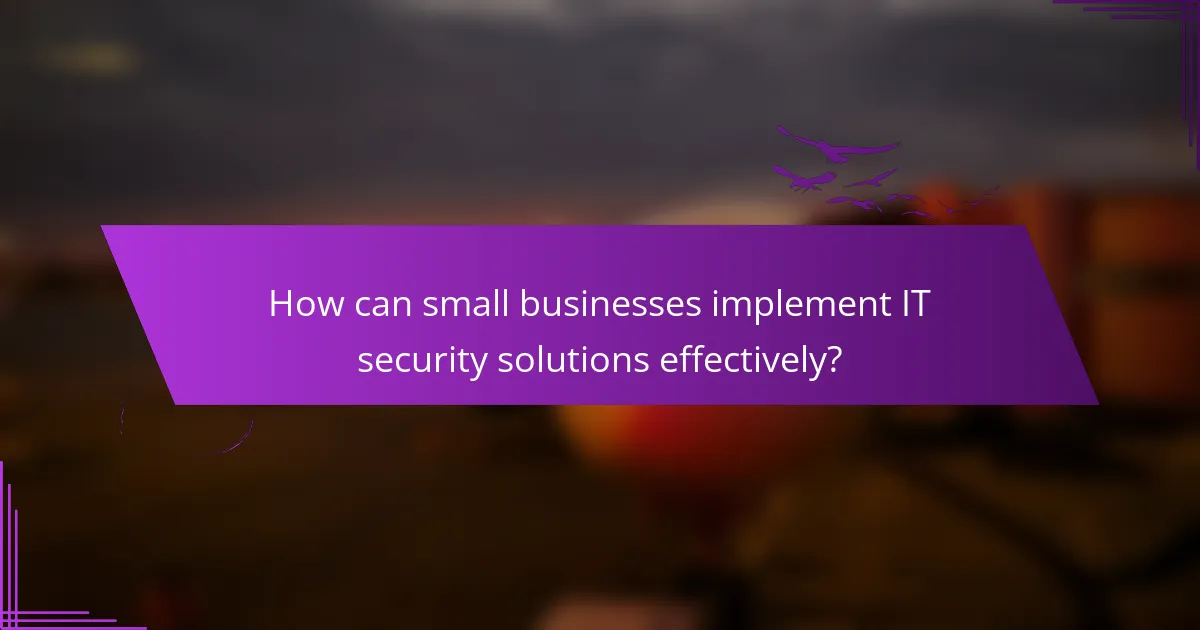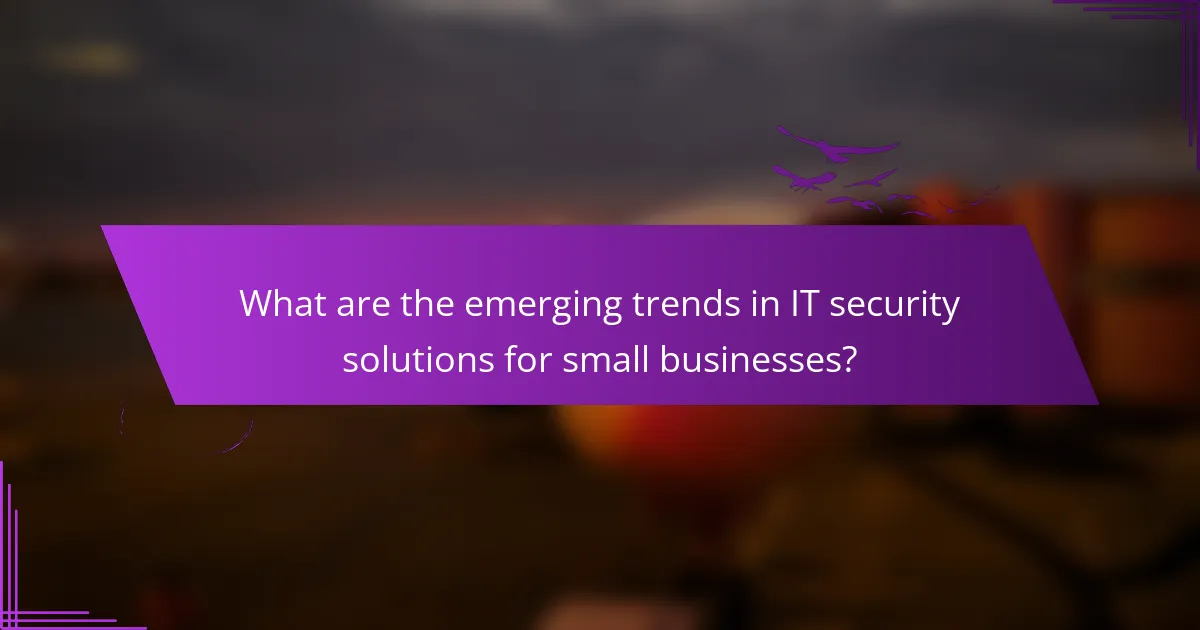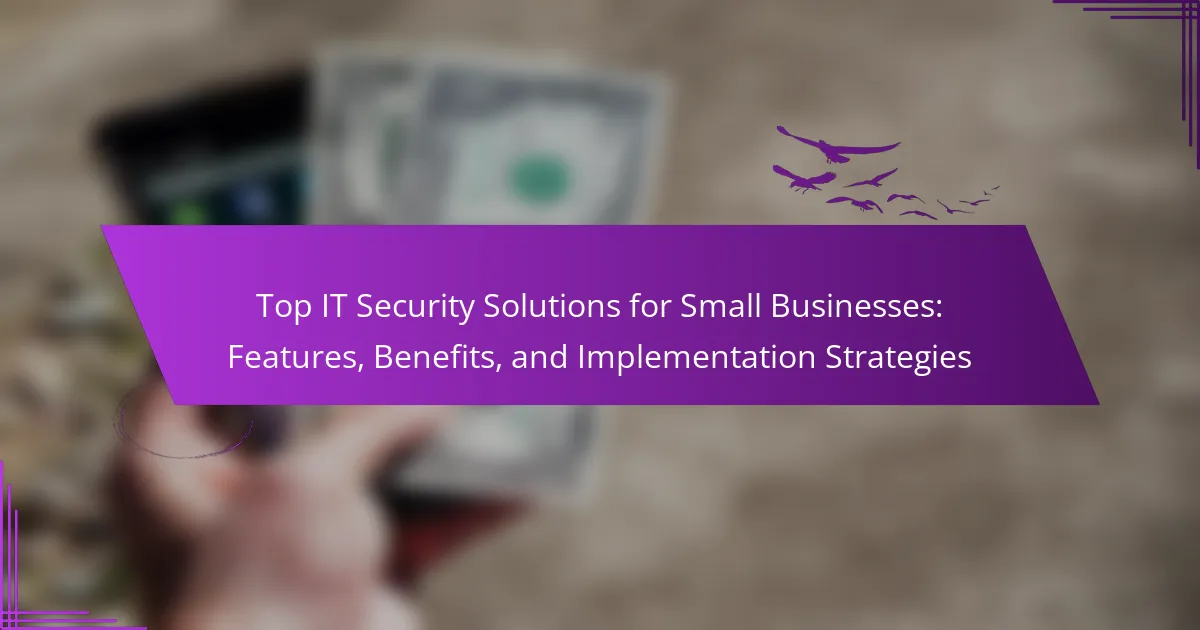
What are the Top IT Security Solutions for Small Businesses?
The top IT security solutions for small businesses include antivirus software, firewalls, and encryption tools. Antivirus software protects against malware and viruses. Firewalls act as barriers between trusted and untrusted networks. Encryption tools secure sensitive data during transmission. Additionally, multi-factor authentication enhances access security. Regular software updates ensure protection against vulnerabilities. Employee training on security best practices reduces human error. These solutions collectively strengthen a small business’s cybersecurity posture.
How do these solutions protect small businesses from cyber threats?
These solutions protect small businesses from cyber threats by implementing multiple layers of security. They utilize firewalls to block unauthorized access to networks. Antivirus software detects and removes malware before it can cause harm. Encryption secures sensitive data, making it unreadable to unauthorized users. Regular software updates patch vulnerabilities in systems, reducing the risk of exploitation. Employee training programs raise awareness about phishing and social engineering attacks. Backup solutions ensure data recovery in case of a breach. According to a report by Cybersecurity Ventures, cybercrime is projected to cost businesses $10.5 trillion annually by 2025, highlighting the critical need for these protective measures.
What types of cyber threats do small businesses face?
Small businesses face various types of cyber threats. These include malware attacks, which can compromise sensitive data. Phishing scams are another significant threat, targeting employees to gain access to company information. Ransomware attacks can lock businesses out of their own systems until a ransom is paid. Insider threats also pose risks, as employees may unintentionally or intentionally leak sensitive information. Additionally, distributed denial-of-service (DDoS) attacks can disrupt business operations by overwhelming servers. According to the 2023 Cybersecurity Report, 43% of cyber attacks target small businesses, highlighting their vulnerability.
How effective are these solutions against specific threats?
These IT security solutions are highly effective against specific threats. They provide protection against malware, phishing, and ransomware attacks. For instance, antivirus software can detect and eliminate malware before it causes harm. Firewalls block unauthorized access, reducing the risk of data breaches.
Email filtering solutions significantly lower phishing attempts by identifying and quarantining suspicious emails. Additionally, endpoint protection solutions safeguard devices from various cyber threats.
According to a 2022 report by Cybersecurity Ventures, implementing these solutions can reduce the risk of a successful cyber attack by up to 80%. This statistic underscores their importance in maintaining small business security.
What features should small businesses look for in IT security solutions?
Small businesses should prioritize several key features in IT security solutions. These include strong encryption, which protects sensitive data from unauthorized access. Multi-factor authentication adds an extra layer of security, ensuring that only authorized users can access systems. Regular software updates are crucial for protecting against vulnerabilities. A user-friendly interface is important for ease of use by staff. Comprehensive customer support enhances the ability to resolve security issues quickly. Additionally, compliance with industry regulations ensures that businesses meet legal requirements. Lastly, scalability allows security solutions to grow alongside the business. These features collectively enhance the overall security posture of small businesses.
What are the essential features of a robust IT security solution?
A robust IT security solution must include threat detection, data encryption, and access control. Threat detection identifies and responds to potential security breaches in real time. Data encryption protects sensitive information from unauthorized access. Access control ensures that only authorized users can access specific systems or data. Additionally, regular software updates are essential to patch vulnerabilities. A comprehensive backup system safeguards data against loss. Multi-factor authentication adds an extra layer of security for user accounts. Finally, employee training on security best practices is crucial to minimize human error. These features collectively enhance the overall security posture of an organization.
How do these features enhance security for small businesses?
These features enhance security for small businesses by providing advanced protection against cyber threats. They include firewalls, encryption, and intrusion detection systems. Firewalls block unauthorized access to networks, reducing the risk of data breaches. Encryption secures sensitive information, making it unreadable to unauthorized users. Intrusion detection systems monitor network activity for suspicious behavior, allowing for rapid response to potential threats. According to a report by Cybersecurity Ventures, cybercrime is projected to cost businesses $10.5 trillion annually by 2025. Implementing these security features significantly mitigates these risks and protects business assets.
What are the benefits of implementing IT security solutions?
Implementing IT security solutions protects sensitive data from unauthorized access. This reduces the risk of data breaches, which can cost businesses an average of $3.86 million per incident according to IBM’s Cost of a Data Breach Report 2020. IT security solutions also enhance regulatory compliance, helping businesses avoid fines and legal issues. Additionally, they improve customer trust, as clients feel safer knowing their information is secure. These solutions can also increase operational efficiency by preventing downtime caused by cyberattacks. Furthermore, they provide a proactive approach to identifying vulnerabilities before they are exploited. Overall, the benefits of IT security solutions are significant for safeguarding business assets and maintaining a competitive edge.
How do IT security solutions contribute to business continuity?
IT security solutions enhance business continuity by protecting critical data and systems from cyber threats. They prevent data breaches, which can disrupt operations and lead to financial losses. Effective security measures, such as firewalls and intrusion detection systems, safeguard against unauthorized access. Regular data backups ensure that information can be restored in case of an incident. Compliance with security regulations also mitigates legal risks associated with data loss. According to a study by IBM, companies with strong cybersecurity measures can reduce the cost of a data breach by an average of $1.25 million. Thus, IT security solutions are essential for maintaining uninterrupted business operations.
What cost savings can small businesses expect from these solutions?
Small businesses can expect significant cost savings from implementing IT security solutions. These solutions reduce the risk of data breaches, which can cost an average of $200,000 per incident. By preventing such breaches, businesses save on potential legal fees and regulatory fines. Additionally, these solutions can lower insurance premiums by demonstrating a commitment to security. They also minimize downtime caused by cyberattacks, which can lead to substantial revenue loss. Investing in proactive security measures is often cheaper than reactive recovery efforts. Overall, the financial benefits of IT security solutions can outweigh their initial costs.

How can small businesses implement IT security solutions effectively?
Small businesses can implement IT security solutions effectively by adopting a multi-layered approach. This includes conducting a thorough risk assessment to identify vulnerabilities. Businesses should then establish security policies and protocols tailored to their specific needs. Regular employee training on security awareness is crucial. Implementing firewalls and antivirus software is also essential to protect against threats. Regularly updating software and systems helps close security gaps. Additionally, businesses should back up data frequently to prevent loss. Engaging with IT security professionals can provide expert guidance and support. According to the Cybersecurity & Infrastructure Security Agency, 60% of small businesses that experience a cyber attack go out of business within six months.
What steps should be taken to assess security needs?
Identify the assets that require protection. This includes data, hardware, and software. Conduct a risk assessment to evaluate potential threats and vulnerabilities. Analyze the likelihood and impact of each identified risk. Determine the current security measures in place and their effectiveness. Engage stakeholders to gather insights on security concerns. Prioritize security needs based on the assessment findings. Develop a comprehensive security plan addressing identified gaps. Regularly review and update the security assessment to adapt to evolving threats.
How can businesses identify their specific vulnerabilities?
Businesses can identify their specific vulnerabilities through comprehensive risk assessments. These assessments evaluate potential threats and weaknesses in systems and processes. Regular audits of IT infrastructure help to uncover security gaps. Employee training on cybersecurity practices can reveal human-related vulnerabilities. Utilizing vulnerability scanning tools provides automated insights into system weaknesses. Engaging third-party security experts offers an external perspective on vulnerabilities. Monitoring industry trends and threat intelligence assists in recognizing emerging risks. According to a 2021 study by Cybersecurity & Infrastructure Security Agency, 85% of breaches involve human error, underscoring the importance of training and awareness.
What role does employee training play in implementation?
Employee training is crucial for effective implementation of IT security solutions. It ensures that employees understand security protocols and best practices. Well-trained staff are less likely to make errors that could lead to security breaches. According to a study by IBM, organizations with comprehensive training programs can reduce security incidents by 70%. Furthermore, training fosters a culture of security awareness within the organization. This culture encourages employees to actively participate in safeguarding sensitive information. Overall, employee training enhances the success of IT security implementations and mitigates risks.
What are the best practices for integrating IT security solutions?
The best practices for integrating IT security solutions include conducting a thorough risk assessment. This assessment identifies vulnerabilities within the organization’s IT infrastructure. Next, organizations should develop a comprehensive security policy that outlines security protocols and procedures. Employee training is essential to ensure that all staff understand their role in maintaining security. Regular updates and patches for software and hardware help protect against known vulnerabilities. Implementing multi-factor authentication enhances access control for sensitive systems. Continuous monitoring of network activity allows for the detection of potential threats in real-time. Lastly, establishing an incident response plan prepares the organization to respond effectively to security breaches. These practices are supported by industry standards such as NIST and ISO 27001, which provide frameworks for effective IT security integration.
How can small businesses ensure seamless integration of new solutions?
Small businesses can ensure seamless integration of new solutions by conducting thorough needs assessments. This involves identifying specific business requirements and aligning them with potential solutions. Clear communication with team members about the integration process is essential. Training staff on new systems enhances user adoption and reduces resistance. Additionally, phased implementation allows for gradual adjustment and troubleshooting. Continuous monitoring of performance post-integration helps identify and resolve issues quickly. According to a study by McKinsey, effective change management can improve project outcomes by up to 30%.
What common challenges might arise during implementation?
Common challenges during implementation of IT security solutions include resistance to change, lack of training, and budget constraints. Resistance to change occurs when employees are accustomed to existing processes. This can hinder the adoption of new security measures. Lack of training leads to inadequate understanding of the new systems. Employees may struggle to utilize security features effectively without proper guidance. Budget constraints can limit the resources available for implementation. This may result in insufficient tools or personnel to execute the security strategy effectively. Additionally, integration issues with existing systems can complicate the implementation process. These challenges are often cited in industry reports, highlighting their prevalence in small business environments.

What are the emerging trends in IT security solutions for small businesses?
Emerging trends in IT security solutions for small businesses include increased adoption of cloud security services. Small businesses are shifting to cloud-based security to enhance scalability and flexibility. Another trend is the integration of artificial intelligence for threat detection. AI can analyze vast amounts of data to identify unusual patterns indicative of security threats. Additionally, small businesses are prioritizing employee training in cybersecurity awareness. Educated employees can significantly reduce the risk of phishing attacks and data breaches. The use of multi-factor authentication is also becoming more common. This adds an extra layer of security beyond just passwords. Finally, the implementation of zero-trust security models is gaining traction. This approach assumes that threats could be internal or external, requiring continuous verification of user access.
How is the landscape of IT security evolving for small businesses?
The landscape of IT security for small businesses is rapidly evolving due to increasing cyber threats. Small businesses are now prime targets for cyberattacks, with 43% experiencing attacks in the past year. This shift has led to a greater emphasis on adopting advanced security solutions. Many small businesses are implementing multi-factor authentication to enhance security. Additionally, cloud-based security solutions are becoming more popular due to their scalability and cost-effectiveness. The rise of remote work has also necessitated stronger endpoint security measures. Furthermore, regulatory compliance is driving small businesses to invest in robust security frameworks. Overall, the evolution is characterized by a proactive approach to safeguarding sensitive data.
What new technologies are shaping IT security solutions?
Emerging technologies are significantly shaping IT security solutions. Artificial intelligence (AI) enhances threat detection and response capabilities. Machine learning algorithms analyze vast data sets for unusual patterns. Cloud security solutions provide scalable protection for remote operations. Zero Trust architecture enforces strict access controls regardless of user location. Blockchain technology ensures secure data transactions and integrity. Extended detection and response (XDR) solutions unify security tools for comprehensive visibility. These technologies collectively improve resilience against evolving cyber threats.
How can small businesses stay ahead of security trends?
Small businesses can stay ahead of security trends by regularly updating their security protocols and investing in employee training. Implementing multi-factor authentication and regular software updates can significantly reduce vulnerabilities. Additionally, adopting threat intelligence tools helps businesses stay informed about emerging threats. Regularly conducting security audits identifies potential weaknesses in the system. Utilizing cloud services with robust security measures enhances data protection. According to a 2021 report by Verizon, 43% of cyberattacks target small businesses, emphasizing the need for proactive security measures. Investing in cybersecurity insurance can also provide a safety net against potential breaches.
What practical tips can small businesses follow to enhance their IT security?
Small businesses can enhance their IT security by implementing strong password policies. This includes requiring complex passwords and regular updates. They should also utilize multi-factor authentication for added protection. Regular software updates are crucial to close security vulnerabilities. Conducting employee training on cybersecurity best practices helps mitigate risks. Regularly backing up data ensures recovery in case of an attack. Implementing a firewall can protect against unauthorized access. Finally, conducting security audits can identify weaknesses in the system. These measures collectively strengthen IT security for small businesses.
What are the most effective strategies for ongoing security management?
The most effective strategies for ongoing security management include regular security assessments, employee training, and incident response planning. Regular security assessments help identify vulnerabilities and ensure compliance with regulations. Employee training raises awareness about security threats and promotes best practices. Incident response planning prepares organizations to respond quickly to security breaches, minimizing damage. Implementing multi-factor authentication adds an extra layer of security. Regular software updates and patch management protect against known vulnerabilities. Additionally, maintaining a robust data backup strategy ensures data recovery in case of an attack. These strategies collectively enhance overall security posture and resilience against threats.
How can businesses create a culture of security awareness among employees?
Businesses can create a culture of security awareness among employees by implementing regular training programs. These programs should cover current security threats and best practices. Engaging employees with interactive sessions can enhance retention of information. Businesses should also promote open communication about security issues. Encouraging reporting of suspicious activities fosters a proactive approach. Regular updates on security policies and procedures are essential. Incorporating real-life scenarios can make training more relatable. Statistics show that organizations with ongoing training reduce security incidents significantly.
The main entity of the article is IT security solutions for small businesses. This article provides an overview of essential IT security solutions, including antivirus software, firewalls, encryption tools, and multi-factor authentication, highlighting their features and benefits in protecting against various cyber threats. It discusses the importance of implementing a multi-layered security approach, employee training, and regular software updates to enhance cybersecurity posture. Additionally, the article outlines best practices for assessing security needs, integrating solutions, and staying ahead of emerging trends in IT security, ultimately emphasizing the critical role of these measures in ensuring business continuity and cost savings.
